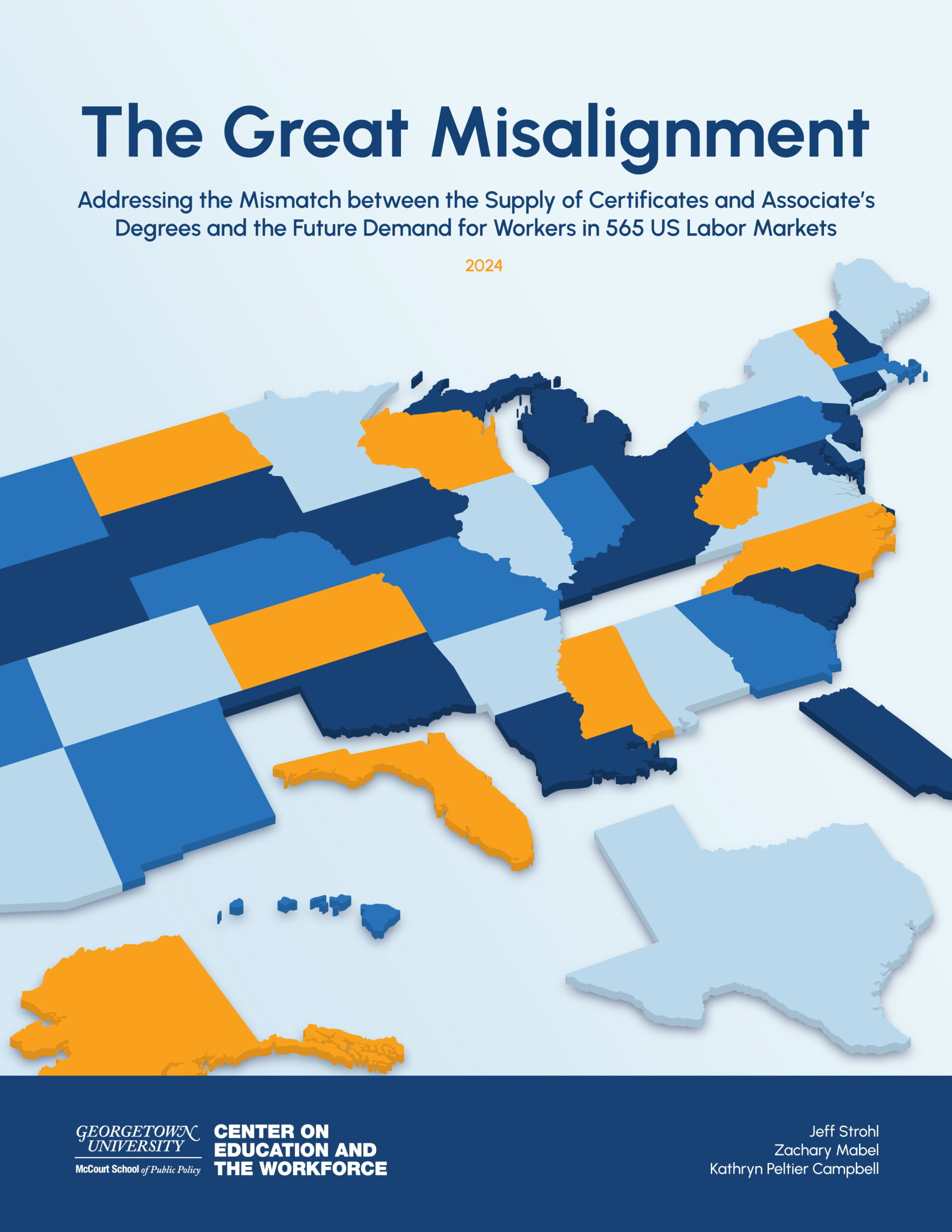Summary
Los Angeles. Atlanta. Savannah. Pittsburgh. Hundreds of local labor markets fuel the American economy, and each one is driven by the needs of the local area’s mix of industries and the skills of its workers. When these needs and skills align, everyone can benefit. But many local economies are struggling to achieve strong alignment between the demand for middle-skills credentials (certificates and associate’s degrees) and the supply of these credentials produced by local institutions.
The Great Misalignment: Addressing the Mismatch between the Supply of Certificates and Associate’s Degrees and the Future Demand for Workers in 565 US Labor Markets demonstrates that in half of the nation’s labor markets, at least 50 percent of all middle-skills credentials would need to be granted in different fields of study to meet projected labor demand through 2031.
Source: Georgetown University Center on Education and the Workforce (GUCEW) analysis of data from the US Census Bureau, American Community Survey (ACS), 2012–21; US Department of Education, Integrated Postsecondary Education Data System (IPEDS), 2019–21; and GUCEW State Job Projections data set, 2023.
Note: Values may not sum to 100 percent due to rounding.
Middle-Skills Misalignment in 565 Local Labor Markets
The extent of middle-skills misalignment varies widely across the 565 local labor markets in the US that have at least one middle-skills credential provider. One-quarter of these local labor markets would need to redistribute up to 42 percent of the middle-skills credentials conferred locally to align the distribution of credentials with the distribution of projected job openings. Another one-quarter would need to redistribute more than 60 percent of middle-skills credentials. For example, the level of credentials-to-jobs misalignment is more than 70 percent higher in Los Angeles than in Atlanta.
Use the map to explore alignment metrics for each local area.
Source: Georgetown University Center on Education and the Workforce (GUCEW) analysis of data from the US Census Bureau, American Community Survey (ACS), 2012–21; US Department of Agriculture, Commuting Zones and Labor Market Areas, 2012; US Department of Education, Integrated Postsecondary Education Data System (IPEDS), 2019–21; and GUCEW State Job Projections data set, 2023.
Sources of Middle-Skills Misalignment
An important driver of misalignment in a local economy is the number of middle-skills providers in the area. Labor markets served by more middle-skills education and training providers tend to experience lower levels of credentials-to-jobs misalignment than those served by fewer providers. Our research suggests that this is because each provider prioritizes programs that fill different, but complementary, labor-market needs. Given that rural areas often have fewer providers, misalignment is typically higher in rural labor markets than in urban ones.
Another major source of middle-skills misalignment is the large percentage of credentials that have little or no direct connection to a specific occupational cluster. For example, 28 percent of all middle-skills credentials awarded nationwide have no direct occupational match. More than 90 percent of these credentials are granted in liberal arts, general studies, and humanities programs. While it is very likely that students pursuing credentials in these fields do so for reasons other than workforce preparation, such as anticipated transfer to a four-year institution, only 42 percent of certificate and associate’s degree completers in liberal arts, general studies, and humanities programs transfer to four-year institutions within six years. Given the risk that they will not successfully transfer to a four-year program, graduates in fields with no direct connection to an occupation may experience particularly difficult transitions from school to work.
Racial/Ethnic Disparities
Where individuals live has always affected their access to educational and professional opportunities. Most working-age adults in the US live within commuting distance of a local middle-skills provider. However, American Indian/Alaska Native adults are 3 to 18 times more likely than working-age adults in other racial/ethnic groups to live in an area without a local middle-skills provider, and living on tribal lands explains only some of this difference.
Additional racial/ethnic disparities arise when considering areas served by at least one middle-skills provider. In these areas, for example, Hispanic/Latino adults are 1.3 to 1.6 times more likely than adults of other racial/ethnic backgrounds to live in areas with poor alignment. Thus, the geography of opportunity is not providing middle-skills graduates of different racial/ethnic backgrounds with equal chances of working in jobs that align with their knowledge, training, and skills.
Source: Georgetown University Center on Education and the Workforce (GUCEW) analysis of data from the US Census Bureau, American Community Survey (ACS), 2012–21; US Department of Agriculture, Commuting Zones and Labor Market Areas, 2012; US Department of Education, Integrated Postsecondary Education Data System (IPEDS), 2019–21; and GUCEW State Job Projections data set, 2023.
Note: The sample is restricted to adults ages 18–65 living in labor markets served by at least one middle-skills education or training provider.
Recommendations
Policymakers and stakeholders need to help middle-skills providers be more responsive to the needs of their students and economies by
- focusing on alignment across institutions to foster more coordination across local providers,
- improving data practices so efforts to align credential production with projected demand are well-informed,
- investing in counseling services that maximize students’ use of data when they select education and career paths, and
- improving career preparation and transfer pathways to bachelor’s degree programs in fields with no direct occupational match.
Resources
The Great Misalignment: Addressing the Mismatch between the Supply of Certificates and Associate’s Degrees and the Future Demand for Workers in 565 US Labor Markets examines the extent to which middle-skills providers are awarding credentials in fields that align with local workforce needs.

